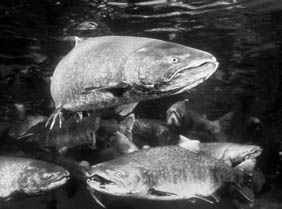|
|
Aaron Penney, Fisheries Program, discusses the background on the Nez Perce Fisheries Resources Management Department. (Interviewed by Josiah Pinkham in January 2002) |
The Department of Fisheries Resources Management has a vital mission in restoring, protecting and perpetuating the health and well-being of all the fish populations in Nimíipuu country.
|
|
Aaron Penney, Fisheries Program, discusses some of the production activities of the Nez Perce Fisheries Program. (Interviewed by Josiah Pinkham in January 2002) |
Among other responsibilities, the Fisheries Department has been entrusted with the recovery and restoration of all fish populations, both anadromous and resident fish. With programs and divisions in conservation enforcement, watershed management, production, and research. The Fisheries Department has operations ranging from culvert construction and stream bank stabilization along the streams of the Lolo Creek watershed to the multi-tribe and multi-governmental agency cooperative work in the Wy-Kan-Ush-Mi Wa-Kish-Wit (Spirit of the Salmon) - Columbia River Anadromous Fish Restoration Plan under the coordination of the Columbia River Inter-Tribal Fish Commission. In addition to the Nez Perce, membership in CRITFC includes the Umatilla, Warm Springs, and Yakama Tribes, as well as the involvement of various state and federal entities.
|
|
Aaron Penney, Fisheries Program, discusses the Cryo-Preservation project in the Nez Perce Fisheries Program. (Interviewed by Josiah Pinkham in January 2002) |
|
|
Aaron Penney, Fisheries Program, discusses the nature of the new Nez Perce hatchery (located on the Clearwater at Cherry Lane, the 1705 Alottment), under construction at the time of filming. (Interviewed by Josiah Pinkham in January 2002) |
The Production Division of the Fisheries Department focuses on using surplus adult fish and hatchery production to restore natural spawning runs and to create improved harvest opportunities. In addition to production operations at McCall (Idaho), along the Wallowa River (Oregon), and at various sites along the Snake River (Idaho), the construction of the new tribal hatchery is based upon a unique blend traditional fishing practices and values, and state-of-the-art scientific expertise. Soon to open, its future production goal will be 1.4 million fall chinook smolts (juvenile fish at least one year old who have adapted to the marine environment) and 650,000 spring chinook juveniles each year. The end result of all these programs and endeavors will be to produce a healthy and productive ecosystem for all in the region to enjoy.
|
|
Aaron Penney, Fisheries Program, discusses the use of dead fish carcasses in the Nez Perce Fisheries Program. (Interviewed by Josiah Pinkham in January 2002) |
As with the wolf, because of the integral role salmon have in the Nimíipuu way of life, economically as well as spiritually, when the salmon or the wolf is endangered, the people themselves become endangered. The welfare of these fish and animals is a direct reflection on the heath and welfare of the Nimíipuu people.
| |
Elmer Crow, with the Fisheries Program, explains how the tribe is restoring the land to its pristine character in the example of Tunnel Pond, close to where Lewis and Clark camped near Orofino. (Interviewed by Rodney Frey, October 2001) |
The Tunnel Pond Reclamation Project is exemplary of Nimíipuu reclamation projects being initiated throughout the reservation. Following a flood and train wreck in the 1930s, Tunnel Pond was formed along the Clearwater River, near Orofino. However, the wreck created a very unhealthy pond, with garbage, two fuel tanks and railroad ties littering the site. The pond itself was becoming stagnate. The Nez Perce Fisheries Department removed 2,000 cubic yards of debris, the fuel tanks and railroad ties. To enhance the hydrostatic flow of the pond, a new side channel to the river was cut and an underground spring was accessed. Soon native frogs, beaver, ducks, geese, muskrat, osprey, eagle, blue heron, turkey and deer had taken up residence in the area. The pond is stocked with trout, and children under 14 year of age can fish for free.
© Nez Perce Tribe 2002
< previous |
next > |





